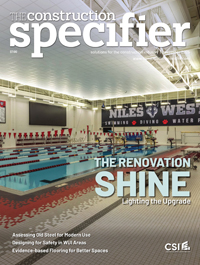Beware of falling ice and snow

by Michael Carter, CET
The building envelope’s fundamental purpose is to offer protection from the elements, providing comfort and safety to occupants within. However, in the quest for improved performance and innovation, additional roles and requirements have arisen. These range from core competencies like structural integrity, fire safety, and egress to improvements in areas such as thermal comfort, daylighting, energy conservation, and artistic expression. Could this ability to provide protection from the elements—the envelope’s core purpose—
be inadvertently compromised by conflicting roles and requirements?
Specifically in the context of winter performance:
- Could the influences of new design methods, materials, and systems be affecting envelope performance in unforeseen ways?
- Could the resultant complexity of the design process as a whole cause disconnects resulting in missed opportunities to avoid hazard or ask the correct questions?
This article focuses on the expectation for a building’s envelope to be free from the formation and release of hazardous ice and snow. It further proposes the causes, influences, and disconnects with the design process are not always recognized and addressed. To explore this topic, it takes a Q&A format to provide answers to common questions asked by building designers, owners, developers, and managers.
The knowledge and experience employed to answer these questions has been gained through more than two decades of ice and snow consulting, field experience, incident investigations, and mockup laboratory tests conducted on all types of buildings and structures. The article’s goal is to educate through experiences and insights gleaned, hopefully supporting future informed discussions and decisions during design meetings that will ultimately reduce the potential for hazard and missed opportunity to reduce design and operational risk.
As a general overall insight to be kept in mind while reading this article: the primary concern expressed by building owners and managers in these crises is the lack of forethought and awareness a falling ice and snow incident could occur, resulting in the existence of unmanaged risk.
Why does it seem there is an increase in ice- and snow-release incidents?
Design and construction practices are changing in many ways—trends toward energy conservation, unique architecture, larger and taller buildings, and use of advanced technologies and materials are having an impact on the performance of a building within its environment. In the days before energy conservation, buildings were generally constructed as large boxes that leaked heat from every façade and surface. Single-pane glazing, double-brick walls, and moderately insulated roofs created relatively warm exterior surfaces, which would melt ice and snow on contact (or in a relatively short time).
In these modern times of extreme insulation, double- and triple-pane glazing, and efficient internal heating strategies, the outside skins of buildings are much colder. Further complicating matters, architects call for unique curves, slopes, and shapes that gather more snow than would a simple vertical wall topped by a tall parapet at the edge of a flat roof. Additionally, heat-reduction strategies (e.g. solar shading devices, low-flow or non-perimeter HVAC systems, insulated glass, and thermal breaks) are often specified with little realization of the implications for the skin’s exterior. The result is buildings in colder climates can become ice-generators, promoting melt and refreeze into more hazardous hardened snow, ice, and icicles that can then release and fall—often significant distances—to the building’s base, thanks to the influence of wind.



